
by California Casualty | Educators |
Your teachers and educational support professionals are at the forefront, expertly balancing student needs with administrative demands and navigating the educational landscape with grace and skill. They give their all, day in and day out, and you want to make sure they feel supported. Here’s how you can help cultivate a culture of fulfillment and growth.
1. Prioritize the physical and emotional well-being of your staff.
When your staff feels well mentally and physically, they are able to do their best work. On the flip side, when they are burnt out, they have trouble meeting the bare minimum. You can create a school culture that prioritizes mental and physical health.
-
- Tap into your staff’s reasons for going into education. Highlight the reasons during staff meetings and professional development. Remind them by celebrating their successes and supporting them through challenges.
- Encourage staff to practice self-care. Bring in self-care experts for professional development sessions. Organize an after-school yoga session. Provide healthy snacks in the faculty room. Create a library of digital resources on self-care.
- Reduce stressors that can lead to drama. Address issues sooner rather than later. Get rid of competitiveness. Set up teacher mentors. Facilitate an atmosphere of teamwork.
- Don’t overload teachers with responsibilities. Allow catch-up days where you don’t plan formal programming.
2. Be visible and available.
Supportive administrators are accessible and approachable. They are a common presence throughout the school. Faculty and staff have opportunities to interact with them on a daily basis.
-
- Walk the hallways during high traffic times. Be seen by students and staff. Engage them in conversation during recess and lunch.
- Make it a point to greet faculty and staff by name, so they know that you know who they are. Personally welcome new staff, including substitutes.
- Maintain an open-door policy at your office, or if you cannot, post times when you will have open-door office hours. Be accessible before and after school.
- Drop into the teacher lounge and ask how teachers are doing.
3. Respect educators’ time.
Educators and support professionals have a lot on their plate. There’s often more work than hours in the school day. Understanding that your staff’s time is valuable will help guide you in managing staff responsibilities and expectations.
-
- Submit meeting agendas at least 24 hours in advance. This will allow your staff to have time to review it so they can appropriately respond in a meeting.
- Do you have straightforward information to share at a meeting? Send an email instead. Just because a faculty meeting is on the calendar doesn’t mean you have to have one.
- Have a “ditch” meeting. Discuss the activities/responsibilities that can be eliminated. This will allow your staff to focus on priorities.
- Ask for staff input on professional development days. Work with them to schedule meaningful programming that helps them in their jobs.
4. Communicate effectively.
Good communication is important. It ensures that teachers and educational support professionals have the information that they need to get the job done. It also builds relationships and eliminates inefficiencies.
-
- Create a weekly schedule that goes to all staff. Email the schedule early on Monday morning with the most important information and documents hyperlinked. These can include department meeting reminders, agendas, school events, links for teachers to join a testing session, etc. (Pro Tip: Make it a Google doc and you can provide live updates as things change.)
- Add faculty birthdays at the bottom of the weekly schedule to celebrate your staff and their milestones.
- Build in time for peer collaboration. This type of communication gives teachers a chance to share best practices, and gives new teachers the chance to learn.
- Write a handwritten note to staff members to celebrate achievements and to thank them for their service.
5. Provide resources and tools.
Teachers repeatedly spend their own money for classroom supplies. Investing in high-quality curriculum and providing resources for classrooms goes a long way toward supporting teachers and staff.
-
- Find free resources and tools, and educator discounts, and regularly share them with your staff. Ask staff to do the same.
- Seek sources of funding for educational supplies and programs from grants, PTA fundraisers, community donations, etc.
- Work with the local library to borrow/access items from books to technology.
- Post classroom wish lists on the school website so parents and others may donate.
6. Support your teachers’ decisions.
One of the most difficult times for a teacher is when administrator support is lacking when they make difficult decisions on grading or behavior. When parents go over the teacher’s head to the principal, it’s important that the administrator supports the teacher’s decision. Siding with the parent undermines the teacher’s authority.
-
- Meet with the teacher privately to ascertain the extent of the complaint and the reasons that the teacher made the decision.
- Determine ahead of time whether any concessions can be made, with the teacher’s support.
- Meet with the teacher and parent and discuss the situation and possible resolutions.
7. Ensure evaluations are meaningful.
Teacher evaluations can be a source of stress but they don’t need to be. The ultimate goal is to help teachers maximize their effectiveness. Administrators and teachers can get the most out of them when they are done with understanding on both sides.
-
- Pre-game with the teacher. Share the evaluation tool. Discuss the upcoming lesson and what you’ll expect to observe. Ask the teacher if there’s anything that he/she wants you to pay special attention to.
- Send your completed evaluation as soon as possible following the lesson.
- Choose just a few high-impact points that the teacher can focus on for improvement. Provide concrete examples of what he or she can do.
- Make sure to mention the positives. Praise teachers for what they are doing right.
- Do not copy and paste from one teacher’s evaluation to another. Not only could it backfire, but each individual assessment also deserves its own evaluation.
8. Listen and incorporate feedback.
Good listening skills will go a long way in managing staff and helping meet their needs. Teachers and educational support professionals have a lot to share. Tap into their “inside track” as the educators on the front lines.
-
- Ask for feedback on everything from schedules to curriculum to discipline. Then, listen and take notes.
- Discover the “pain points”—the things that are not working well — so that the school may address them.
- Allow teachers to be part of the decision-making process and you will get their buy-in. You also will get some creative and practical solutions.
This article is furnished by California Casualty, providing auto and home insurance to educators, law enforcement officers, firefighters, and nurses. Get a quote at 1.866.704.8614 or www.calcas.com.

by California Casualty | Educators |
This article is written by former New Jersey first grade teacher, Felicia Niven.
Reading is one of the most important skills that we teach. Providing material at a student’s level is key to helping him or her cultivate a love for reading.
We’ve added to our list of leveled reading websites with some new favorites. These sites offer free, high-quality leveled reading passages for your students. For a look at Part 1 of this series, click here.
Epic!
(Grades K-6)
This site offers educators free access to an expansive digital library of popular books. You can create book collections to share with your students. Teachers and students can search by fiction or nonfiction and Lexile level. There’s also a read-aloud option and a dictionary look-up. However, it’s worth noting that your class login code is only active from 7 am to 3 pm when school is in session. This site is best for in-school use, where teachers can curate the content. Parents have to pay for after-school use and there are mixed reviews about the ability to easily source appropriate grade-level material.
National Geographic Explorer Magazine
(Grades K-6)
National Geographic’s student magazines are no longer in print, but the organization has compiled an impressive selection by grade level on its website. With adventurous names for each grade level, from Pathfinder to Pioneer, the titles alone are inspiring. The issues are beautifully illustrated, taking full advantage of nature videos to illustrate some articles. Issues are both in English and Spanish for bilingual readers. You’re provided passwords and QR codes that you can share with students so they may read on their digital devices. There’s also a teacher’s guide that includes lessons, Lexile levels, worksheets, and assessments for each story. Some stories are even linked to Kahoot quizzes.
Newsela
(Grades 3-12)
Newsela offers thousands of news articles for free, but you must create an account to access them. Content is aligned to state standards, with 5 different reading levels. Content is well suited for ELA, social studies, and science, and originates from such sources as Smithsonian, Associated Press, Highlights, and Scientific American. Your customized news library is curated by grade level. There is a filter for elementary content so that your students will only see age-appropriate content. Teachers can assign stories and monitor student progress.
Read Theory
(Grades K-12)
Students take a pre-test that assesses their reading level and then are assigned weekly leveled reading practice. The passages are. similar to those found on standardized tests, but sometimes a bit longer, and they come with quizzes to assess comprehension. Students who score well will gradually increase in difficulty. Those who score poorly will be given easier passages to boost confidence. Teachers can track and monitor performance against Lexile Levels. A paid version of this site allows the assignment of customized passages and more activities such as reading competitions.
Reading IQ
(Grades PreK to 6)
While schools have to pay for Reading IQ, you can apply for a free individual teacher account. The site gives you access to thousands of leveled books, fiction, and nonfiction, all organized by topic and grade level. There are picture books, chapter books, biographies, STEM books, and more. The stories have a real book feel, with pages that “turn.” Prereaders have the option for the book to be read aloud to students, and there are also guided reading options. For home access for students and other options, there is a paid version.
Reading is Fundamental
(Grades K-6)
RIF has a collection of leveled reading passages by grade and Lexile level. Texts are designed for independent reading and may be downloaded as PDFs and printed. There are easy, medium, and hard versions of the same content. However, books linked to the texts do come with a cost, if you choose to incorporate those.
Rewordify
(Upper Elementary – High School)
With Rewordify, you can easily take a text passage and create a simpler version. The site highlights and defines challenging words and phrases. This is ideal if you’re trying to accommodate different levels in your class with the same text. Rewordify also offers a range of classic literature, from the Adventures of Tom Sawyer to War and Peace. In addition, there are options for customized word lists and vocabulary quizzes and you can add links to online lesson plans. The free version lets you do a lot, but a paid account is necessary if you want to save and print documents.
TeachersPayTeachers
(Grades K-7)
Not surprisingly, teachers have developed their own leveled reading passages. It’s worth a visit to TeachersPayTeachers to find options for no-prep digital and printable passages. There are many available for free, and the list is constantly updated.
We’d love to hear from you. Do you have a favorite leveled reading website that you’d like to share? Write it in the comments.
This article is furnished by California Casualty, providing auto and home insurance to educators, law enforcement officers, firefighters, and nurses. Get a quote at 1.866.704.8614 or www.calcas.com.

by California Casualty | Educators |
California Casualty will deliver $1,000 Thomas R. Brown Athletic Grants to educators at 50 public middle and high schools across 25 states to help support their school sports program(s). Since its inception in 2010, the Thomas R. Brown Athletics Grant Program has helped fund burdened athletic programs in 750 public schools across the nation.
The Thomas R. Brown Athletic Grant, named after avid sportsman and California Casualty Chairman, Emeritus Tom Brown, was created based on his belief that lessons learned on athletic fields- teamwork, trust, communication, and confidence- translate in the classroom and beyond. Athletic programs have a positive impact on the students, in turn, positively impacting the schools as these children use the skills they gain from playing sports to become well-rounded students and adults.
“Every year sports programs across the state do more with less. In a small district like ours, this is a very big deal when we know the positive impact sports programs make on our students.” Said one grant application from Washington Colony Athletics in Fresno, CA. “When COVID stopped our athletic program, there was not much to motivate kids to do well in school. Now that we are back playing sports we see grades getting better and the motivation to succeed in and out of class increase. We have a great athletic program that we want to continue to be better.”
California Casualty recognizes the importance of youth sports on children’s physical and mental health. And we are happy to announce that the 2022/2023 Athletic Grants will help specifically fund:
-
- Female soccer uniforms and shoes,
- Lovonya DeJean Middle School, Girls Middle School Soccer Team, Richmond, CA
- New hurdles and a high jump pit,
- Preston Middle School, Track and field, Fort Collins, CO
- Volleyball shoes and kneepads for all team members
- American Dreamer STEM Academy, Volleyball, Decatur, IL
- Cross Country uniforms, training equipment, travel suits, and a travel canopy for weather protection
- Russell County High School, Cross Country, Russel Springs, KY
- Replace outdated and worn uniforms, new basketballs, and ball racks
- Poplar Bluff Junior High, Girls’ Basketball, Poplar Bluff, MO
- Gloves, bats, helmets, catchers gear, balls, bases, and first aid equipment
- Deerfield Twp School, Softball, Rosnhayn, NJ
- Tennis rackets and warm-ups for the cold weather
- Somerset Area School District, Boy’s Tennis, Somerset, PA
- Team balls, towels, and rosin
- Lincoln High School, Girls Bowling, Tacoma, WA
A complete list of 2022/2023 recipients follows.
2022/2023 Thomas R. Brown Athletics Grant Recipients
Alabama
C.L. Scarborough Model Middle School – Mobile, Alabama – Volleyball
Arizona
Palo Verde Middle School – Phoenix, Arizona – Soccer and Basketball
Canyon View High School – Waddle, Arizona – Boys Basketball
California
Washington Colony Elementary School District – Fresno, California – Washington Colony Athletics
Coachella Valley High School – Thermal, California – Boys Tennis
Rancho Alamitos High School – Garden Grove, California – Soccer
Andrew Carnegie Middle School – Orangevale, California – Wrestling
Lodi High School – Lodi, California – Competitive Cheer
Lovonya DeJean Middle School – Richmond, California – Girls Soccer
Mira Monte High School – Bakersfield, California – Track & Field
La Contenta Middle School – Yucca Valley, California – Volleyball
Buena Park High School – Buena Park, California – Girls Soccer
John Still Middle School – Sacramento, California – Basketball
Mountain House High School – Mountain House, California – Girls Soccer
Arboga Elementary School – Arboga, California – Volleyball, Flag Football, Basketball and Track & Field
Colorado
Goddard Middle School – Littleton, Colorado – Volleyball, Basketball, Track & Field and Wresting
Preston Middle School – Fort Collins, Colorado – Track & Field
Fort Morgan High School – Fort Morgan, Colorado – Girls Wrestling
Connecticut
Torrington Middle School – Torrington, Connecticut – Track & Field
Florida
Northview High School – Century, Florida – Track & Field
Idaho
Wallace Jr/Sr High School – Wallace, Idaho – Swim Team
North Junior High School – Boise, Idaho – Boys Basketball
Illinois
American Dreamer STEM Academy – Decatur, Illinois – Volleyball
McHenry Middle School – McHenry, Illinois – Golf
Indiana
North High School – Evansville, Indiana – Flag Football, Basketball, Bowling and Track & Field
Iowa
North Scott Junior High – Eldridge, Iowa – Special Olympics
Kansas
Wellington High School – Wellington, Kansas – Special K Basketball
Lansing Middle School – Lansing, Kansas – Volleyball
Kentucky
Russell County High School – Russell Springs, Kentucky – Cross Country
Maine
Alexander Elementary School – Alexander, Maine – Soccer
Maryland
International High School at Largo – Largo, Maryland – Cheerleading
Missouri
Poplar Bluff Junior High – Poplar Bluff, Missouri – Girls Basketball
Marshall High School – Marshall, Missouri – Girls Wrestling
Montana
Wibaux Junior High School – Wibaux, Montana – Basketball
Nebraska
Chase County Schools – Imperial, Nebraska – Wrestling
New Jersey
Deerfield Township School – Rosnhayn, New Jersey – Softball
Hoboken Middle School – Hoboken, New Jersey – Soccer
Elizabeth Middle School North (School 19) – Elizabeth, New Jersey – Girls Soccer
Ohio
Centerville High School – Centerville, Ohio – Girls Wrestling
Oklahoma
Cheyenne Middle School – Edmond, Oklahoma – Special Olympics
Oregon
Thurston Middle School – Springfield, Oregon – Wrestling
Days Creek Charter School – Days Creek, Oregon – Girls Volleyball
Pennsylvania
Sharpsville Area School District – Sharpsville, Pennsylvania – Girls Soccer
Somerset Area School District – Somerset, Pennsylvania – Boys Tennis
Texas
Atkins Middle School – Lubbock, Texas – Girls Volleyball
Washington
Lincoln High School – Tacoma, Washington – Soccer and Girls Bowling
Meadowdale High School – Lynnwood, Washington – Track & Field and Cross Country
Pacific Middle School – Vancouver, Washington – Soccer
University High School – Spokane Valley, Washington – Softball
Wyoming
Natrona County High School – Casper, Wyoming – Wrestling
This article is furnished by California Casualty, providing auto and home insurance to educators, law enforcement officers, firefighters, and nurses. Get a quote at 1.866.704.8614 or www.calcas.com.
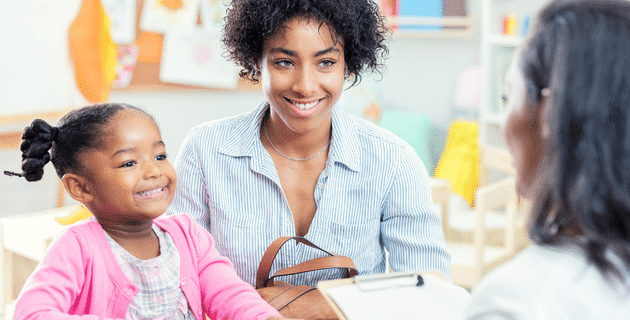
by California Casualty | Educators |
It’s that time of the year again, the time when we share important information about our student’s progress with their families. Parent-teacher conferences are wonderful opportunities to build bridges between home and school. But when you’re faced with doing 2 dozen or more of these meetings back-to-back, it can be daunting.
Whether you’re a newbie or a veteran teacher, here’s how you can prepare for, and organize, your parent-teacher conferences this year.
1. Send a pre-conference letter.
Not only does a letter get parents thinking about conferences, but it can also get them engaged. Include a section that asks for specific questions or concerns that parents want to cover at the conference. There could be a box to check that they have no questions or concerns at this time. See this free sample letter. Manage parent expectations by explaining the conference process and the need to stick to the schedule. Include clear directions on how to sign up for a timeslot.
Pro Tip: Send out the pre-conference letter as a Google form.
2. Schedule enough time.
Not all conferences have to last the same amount of time. Take each student into account and schedule extra time to discuss those who are struggling. You will need to have a more thorough conversation with those parents. You also will want to schedule more time with parents who have a lot of questions. (You’ll know from the pre-conference letters.) Offer flexibility, such as a Zoom, Google Meet, or Skype options for parents who cannot make it to school. They will appreciate that.
Pro Tip: Use a scheduling tool like Calendly or appointment slots on Google Calendar to allow parents to sign up for timeslots that are in-person and/or virtual.
3. Create a script and agenda.
You have a tight timeframe to accomplish a lot. That’s why writing down what you will cover will help. Start by sharing something positive about the student. Then summarize learning goals. Review student grades and work. Share student strengths and areas for growth. Answer questions and give your contact information. Remember that this is just a snapshot, and you can follow up as needed.
4. Gather student work and assessments.
Now that you know what you’re going to cover, it’s time to gather test results and other assessments, work samples, and anecdotal notes for your students. Then you’ll need to separate them by student in folders. Include any behavior concerns. Be honest in a caring way, and stress opportunities for growth.
Pro Tip: Ask students to choose work samples – one piece they are proud of and one where they feel they can improve.
5. Create a waiting space.
Inevitably, parents will show up early or you will run late and they will be waiting. Prepare a sign for the door that tells parents that you are still in a conference. When you are ready for them, you can invite them into the classroom. You also can create a small station where waiting parents can write notes to their children and put them in a class mailbox.
Pro Tip: If you have a classroom device, you can invite parents to leave a funny selfie to surprise their children.
6. Be welcoming.
Greet parents warmly. Sit side-by-side with them as you talk. It’s more friendly and non-threatening than sitting across a desk and sends the message that you are truly partners in their child’s education. Use positive body language. Finally, if parents have to bring their children, have an area set aside with puzzles and quiet activities to limit distractions.
Pro Tip: Prepare for parents who may have a language barrier. In these instances, you can invite them to bring the student to translate or you can ask them to have an interpreter on hand.
7. Encourage questions.
You will likely do most of the talking in a parent-teacher conference. Yet you do want to get parent input. Ask at least twice if they have any questions. Share how they can help their child at home. For example, students struggling with getting homework done can use a planner and parents can check it every night. Make sure that parents have your email address in case they need to contact you following the conference.
8. Remain professional.
You are representing the school. Don’t talk negatively about other teachers or administrators or complain about school policies. Never discuss other students’ behavior. If a parent becomes hostile, don’t argue. Use active listening. Discuss how both parties want what’s best for the child. Invite the parent to a follow-up conversation with you and the administration.
9. Set an alarm.
Your parents may need a cue that the conference is wrapping up. Set an alarm on your phone or another device to ring five minutes before you have to end. This will be a polite reminder that you have other families to see. If more time is needed with this particular parent, now is the time to schedule a follow-up conversation.
10. Practice self-care.
During conference week, you’ll likely log long hours. That’s why self-care is so important. Get enough sleep. Bring snacks and water. Schedule and take bathroom breaks. Plan a low-key, relaxing time leading into, and following, the conferences so that you can recharge.
Pro Tip: Some schools offer free childcare for teachers during conference week. Babysitting is done by PTO volunteers or high school students. Check if this is a possibility.
Finally, consider alternatives to and/or additions to parent-teacher conferences. Student showcases, group conferences, kid conferences, and grade-level dialogues are a few examples of how your district can reinvent the traditional parent-teacher meeting.
This article is furnished by California Casualty, providing auto and home insurance to educators, law enforcement officers, firefighters, and nurses. Get a quote at 1.866.704.8614 or www.calcas.com.

by California Casualty | Educators |
Students learn best when they feel safe, comfortable, and valued. But for students who are being bullied, that’s not the case. Bullying is distracting and anxiety-producing. It affects student self-esteem. It creates an unstable environment for the whole class.
As a teacher, you work hard to create that safe space to learn. Here are some strategies that you can incorporate into your teaching and into your classroom to help keep it that way, and prevent bullying before it starts.
Talk with students about bullying.
Most students know the term “bullying,” but the definition can be confusing. Is name-calling considered bullying? How about gossip? Teach your students that bullying involves words or actions that hurt others intentionally, and that often are repeated. Read and review examples of bullying. Teach kids safe ways they can stand up for others or share that they are being bullied. Your school’s guidance counselor can be a great resource and may even teach the lessons.
Pro tip: Assign a creative writing piece about bullying, such as a poem speaking out against it or a story or skit teaching others to help. Assign an art project about bullying. Display the posters around the classroom and school.
Watch for gateway behaviors.
Behaviors that exclude another student or defy authority are often the actions that can escalate into bullying. These include eye-rolling, staring at others for extended periods, teasing or name-calling, and sarcasm. Laughing when students get hurt or encouraging others to laugh also are concerning behaviors. Finally, excluding or ignoring classmates, refusing to work with certain students, and ignoring teacher or staff instructions are actions that can lead to bullying if not addressed. Make sure that students know that these behaviors are unacceptable in your classroom.
Look out for cliques.
You work hard to foster a sense of community in your classroom. Cliques can undo your good work, and isolate students. That’s why it’s important to keep an eye on them. Rotating seating can help. Use teacher-selected groups so that students get a chance to work with everyone. Remember that students don’t learn to be inclusive on their own, so you will need to teach them.
Look for silent signs of bullying.
When a student is being bullied, there may be subtle shifts in behavior. You may notice changes in the child’s schoolwork or class participation. You may observe signs of anxiety or depression. Maybe there are injuries, torn clothing, or damaged property. If you see any red flags, take the time to talk one-on-one with the student. Determine if there is a potential bullying situation, and then take appropriate action.
Listen to students.
Take every student complaint seriously. You may be the first, and only, trusted adult to be told this information. Don’t take the chance that it’s nothing. Intervene thoughtfully with both the victim and the bully separately. Remember that the bully needs guidance too. Know your students’ personalities. What may be a joke to one student could be humiliating to another.
Pro Tip: Create safe and confidential ways that students can report bullying.
Be visible and close by.
You can’t be everywhere all the time, but when you are working, you can put yourself in places to observe potential bullying situations. Stand outside the class in the hallway during class changes. Walk by the bathroom during high-use times, or by out-of-the-way corners, when your schedule allows. Sometimes the presence of an authority figure can help prevent poor behavior.
If you see bullying, intervene right away.
Avoid thinking that “kids will be kids.” That’s not an acceptable reason for bullying. When you see concerning behavior, stop the interaction. Remember that bullying is not the same as conflict. It is an unbalanced situation. Talk to those involved privately and separately. Follow your school’s protocol for bullying. Re-establish your classroom as a safe space. Keep an eye on those involved to help prevent future situations.
Be aware of cyberbullying.
Cyberbullying can happen outside the classroom and affect what happens in the classroom. Teach students how to protect themselves from cyberbullying. Tell them not to share their passwords. They also should not post anything online that would hurt someone or even share it privately with a friend (as that can be shared with all). Tell students to talk to a trusted adult about any messages that make them feel sad or scared.
Many schools have zero-tolerance policies on bullying with severe consequences such as suspension and expulsion. That can make staff and students less likely to report bullying behavior. Talk with your administration about any concerns you may have, and keep lines of communication open with students, parents, and staff. You can be a caring role model in creating safe spaces for all to learn, grow and find their full potential.
This article is furnished by California Casualty, providing auto and home insurance to educators, law enforcement officers, firefighters, and nurses. Get a quote at 1.866.704.8614 or www.calcas.com.
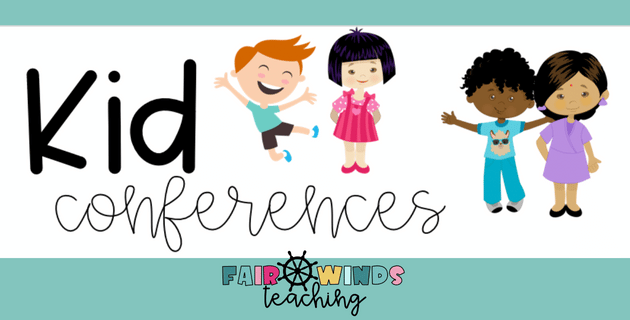
by California Casualty | Educators |
Written by Casey Jeffers, Owner of Fair Winds Teaching & MSEA Second Grade Teacher
Ever wonder why, as elementary and middle school teachers, we meet with our student’s parents and never meet with our students one on one for a conference. Years ago, I held my very first Kid Conference with each one of my students. It was a precursor meeting before I held my October parent teacher conferences. I also always held another one after the long Winter break in January. This was a game changer for me and my students.
A Kid Conference is exactly what it sounds like, a conference with a kid. Some teachers host kid-led conferences, which is a different concept (a great one, but different). A kid-led conference is where you prep a student to lead the meeting you host with the child’s parent or guardian. The student is able to talk to their caregiver about their academics, behavior and more in the classroom. I love having my students lead during conferences and it is much easier for them to do once you host a private conference with them first. You do not have to have kid-led conferences to be able to host your own Kid Conference at school. Both are great and I suggest starting with hosting your very own Kid Conference.
A Kid Conference is a one on one meeting involving the classroom teacher and their student. It should be about 5 minutes long; depending on how many students you have in your classroom, you can make the meeting longer if you choose. With my second and third graders, 5 minutes is plenty to answer the questions that are important. During the conference, I welcome a student to my back table and ask a series of questions to better understand them, their learning style, and more about them as a person. My goal is to get to know them inside and outside the classroom.
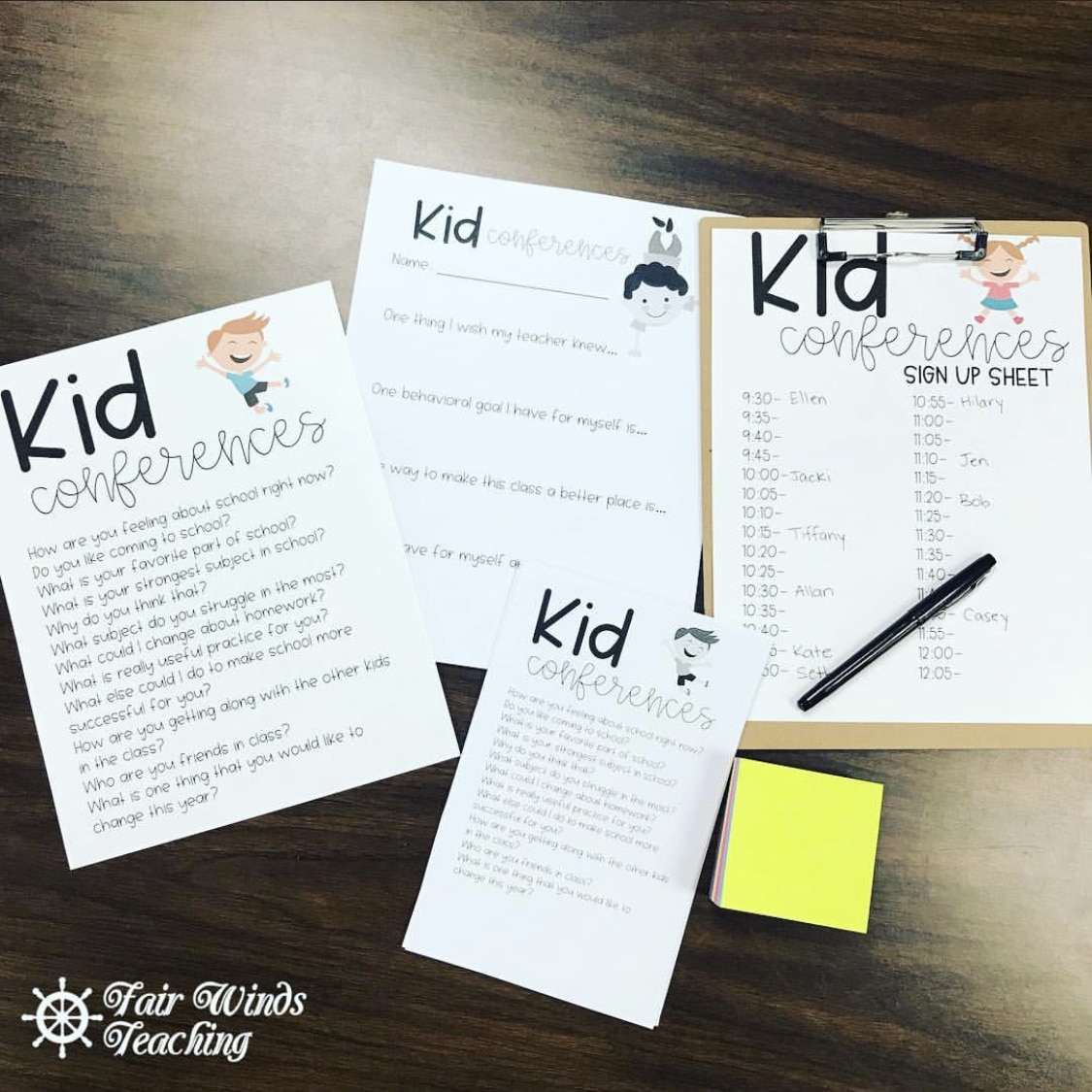
Each of my Kid Conferences happen during the school day. I make sure my class has the directions they need to complete some independent work or centers while I am meeting with each student. Last year, I had my students rotate through my different Starting with STEAM bins to explore with creating.
I provide a sign up sheet for my students to come pick a 5 minute time block; this allows them to pick if they want to meet with me first or later in the day/week. I select times throughout the day that work best for my class’ schedule. They are not all back to back time slots because in order to complete a class of 25, it would take 2 hours. We all know that it would be very hard for elementary school students to focus on independent work for 2 hours straight. I suggest providing time slots for the morning and some in the afternoon over a couple days.
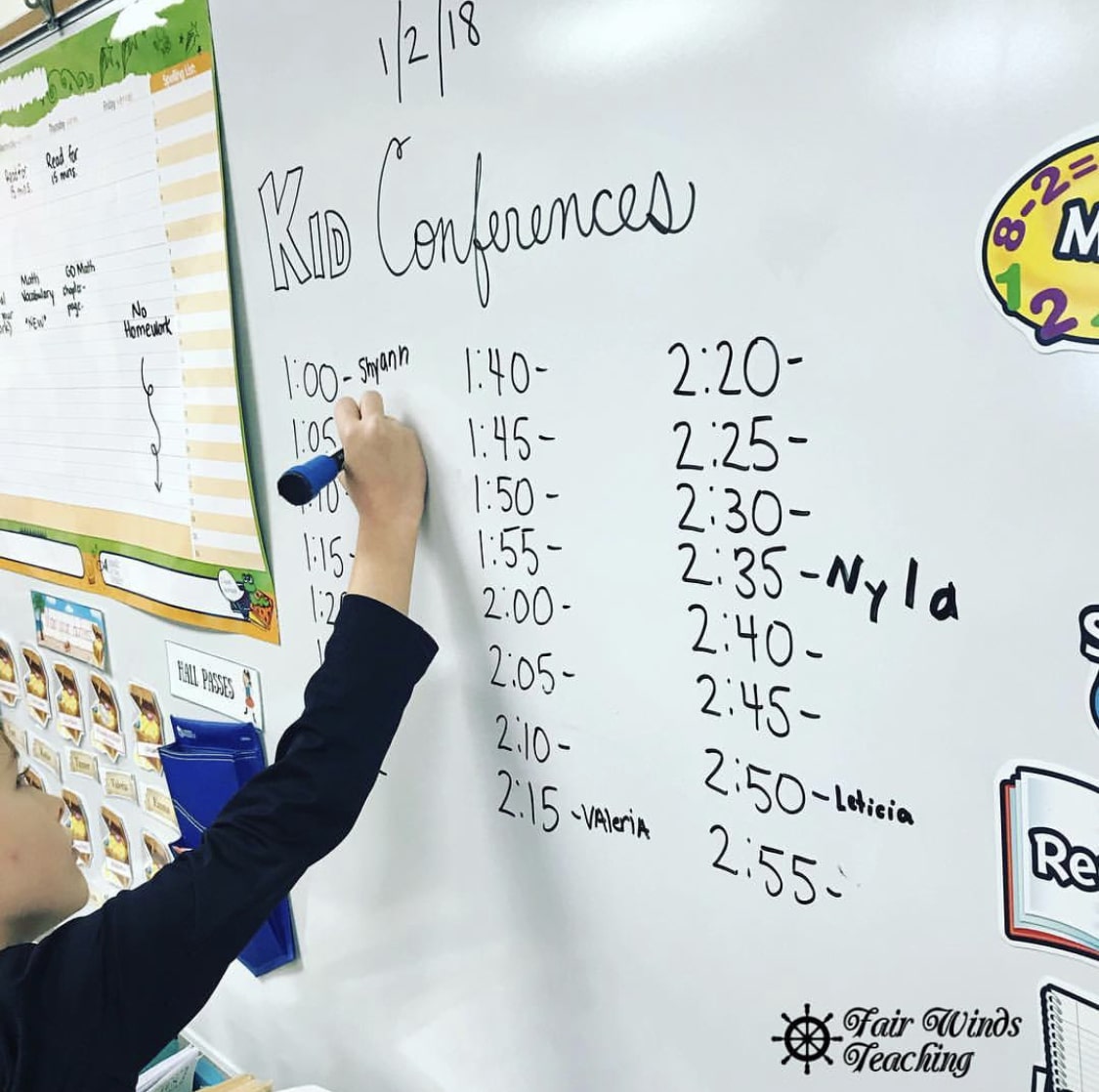
During this time, the students first work on a couple things to get ready for their Kid Conference. I give them a small slip of paper that says, “I wish my teacher knew…” This paper is for them to use if they want to tell me something (about home or school) that they don’t feel comfortable telling me out loud. This allows them to feel as if they have a safe space to let me know about a situation that might affect their schooling. The Kid Conference process in general allows students to open up to you more and share something (since they have one on one time), however, some students might still need that slip of paper to feel comfortable to say it. I have a little box with a sign that I allow all the students to put their “I wish my teacher knew…” slip in. That way, they don’t have to talk with me about it right then.

Each student will also be given a list of questions to read over beforehand to know the questions that will be talked about in the meeting. I also have a QR code available that the students can scan to listen to the questions read to them. I provided this in the resource because I knew I wanted them to be as independent as possible during this time so I can have uninterrupted time with each student.

I then have a list of the questions with a recording sheet for the teacher to use during each Kid Conference to take notes and keep them for their records. This is helpful for me to remember something or circle back to an item I learned about a student in the future. I can also use these notes for my parent teacher conference or my Kid Conference follow up meeting in January.
I can’t stress this enough… The things I learn in these meetings are so VALUABLE! Spending time to get to know your students on a one to one basis is so very important. If you don’t have a relationship with your student, they won’t feel comfortable learning as much from you as possible. We also all know that if something is worrying or bothering a child, it will distract them from their everyday school life.
Use this Kid Conferences sheet of questions, form and sign up sheet to host your next 5 minute student interview. Checking in with your students, creating goals and building relationships is a vital part of the classroom. Print these resources now to use for your own Kid Conference day.
What teachers are saying…
“I loved being able to sit down and conference with my students using this resource! It helped me get to know them better right from the start!” – Sarah C.
“I’ve been using this resource for a while! It is such an awesome idea. I love to give my kiddos some much needed 1-on-1 time…” – Heritage A.
“Great conversation starters with my students and I loved getting more in touch with them!” – Colleen
“This was a great way to start back to school after Winter Break! It allowed me to check in with each student and set goals for the new year 🙂 Thanks!” – Kaytlin G.
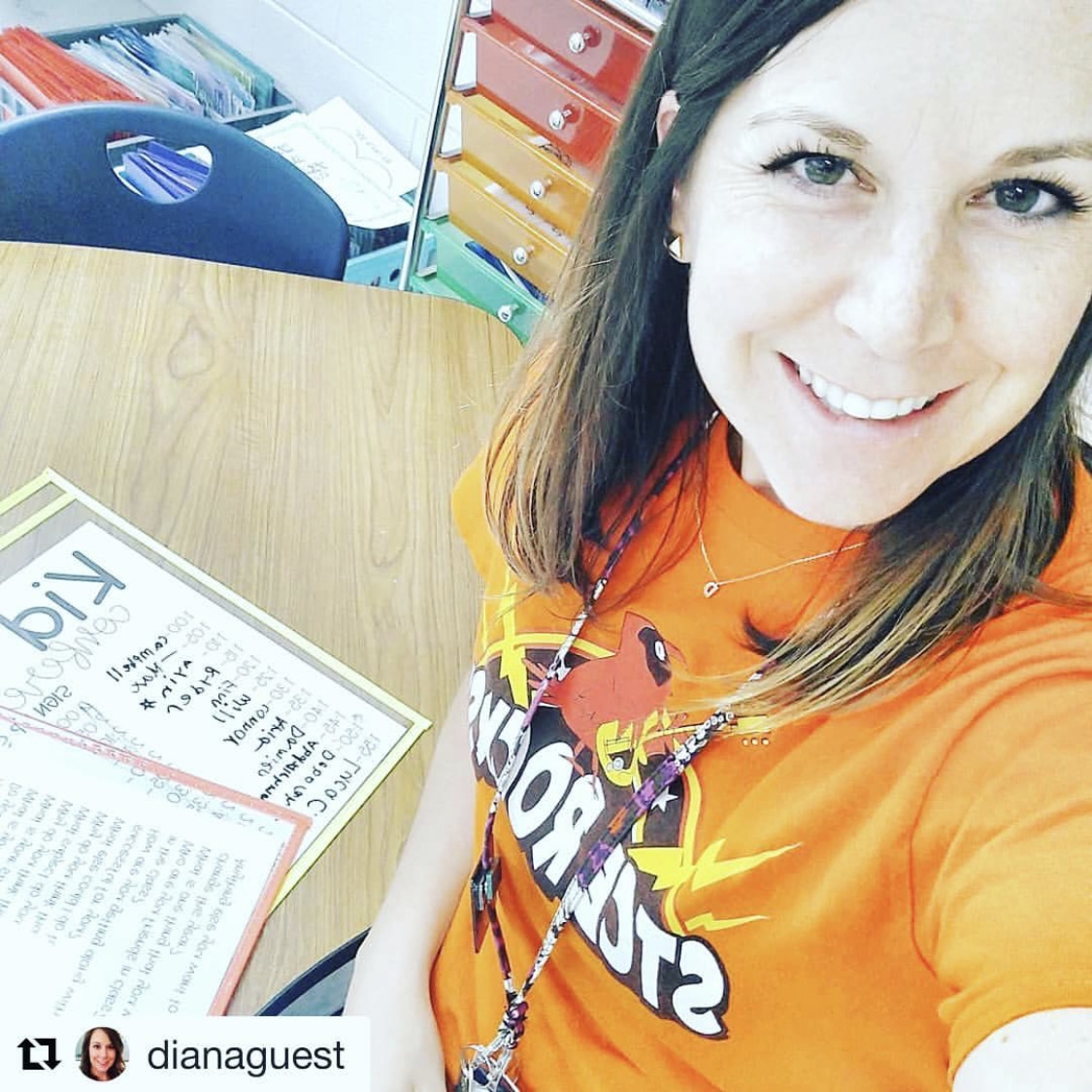

Casey Jeffers is a second-grade teacher at Butterfly Ridge Elementary in Frederick County, Maryland. She was recently recognized as the national winner of the NEA Foundation’s 2021 Teaching in Excellence Award. Casey is the proud owner of the Education Resource Blog, Fair Winds Teaching, and loves to connect with her education community through her TeacherPayTeacher’s business.
Like this article? Then you may also enjoy Casey’s post about Classroom Transformations!












